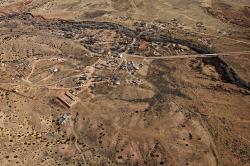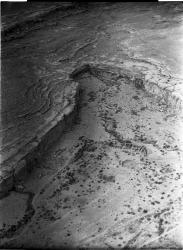Calendar of Events
Oblique Views Exhibition OPENING!
Lecture, Dancers, Booksigning, and Hands-on Activities
October 25, 2015
1:00 pm through 5:00 pm

Galisteo
Galisteo is now considered statistically part of the Santa Fe metropolitan area, although it is still remote and has a population of less than three hundred people. It is home to a number of well-known artists and scholars, as well as families traditionally linked to the area, none of whom farm on the scale of the past. Galisteo Creek no longer washes away vegetation in the streambed, which now appears to be a lush forested strip. The church and cemeteries remain, as does the layout of the colonial village. Traces of the old narrow fields can still be seen. Photograph by Adriel Heisey, 2015.
Sunday, October 25 -- it’s the day to be on Museum Hill for the long-anticipated opening of Oblique Views: Archaeology, Photography and Time.
You’ll see historic images by Charles and Anne Lindbergh side by side with those of contemporary aerial photographer Adriel Heisey -- some of the changes in the landscape (Canyon de Chelly, Chaco Canyon, Galisteo) are profound, others are more subtle.
Photographer Adriel Heisey speaks at 1pm and again at 3pm. The Red Turtle Dancers of Pojoaque and Santa Clara Pueblos will display a butterfly dance, buffalo dance, and rain dance. Dance times are scheduled for 2pm and 4pm.
Of course we’ll have the beautiful hardcover Oblique Views catalog available for purchase, with the contributers all present to sign.
A hands-on photography activity will be offered from 1 - 4pm.
Admission is free on Sundays for New Mexico residents.
See the full color postcard here!

Pueblo del Arroyo
Pueblo del Arroyo lies immediately next to Chaco Wash, and its location inspired its name. When the Lindberghs photographed the site, the circular tri-walled structure on the western extension of the pueblo was being eroded by the wash. Neil Judd excavated a large part of the pueblo in the late 1920s, resulting in the empty rooms visible in both photos. The more modern buildings to the southeast of the ancient pueblo were built by Richard Wetherill in 1899 and served as a boarding house for archaeologists and other visitors. They were converted into the Chaco Canyon Trading Post in the 1930s. The road to Gallup crossed the wash nearby. Photograph by Charles A. and Anne Morrow Lindbergh, 1929.
